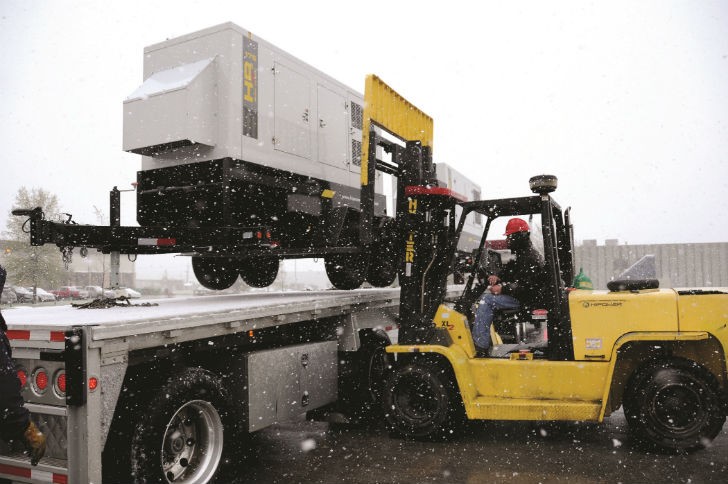Cold Weather Generator Operation
Cold pack enables generator startup and reliable operation in sub-freezing temperatures

Diesel generators are notoriously problematic during cold weather. Not only does diesel fuel become unstable in cold temperatures but when the engine block and heads are cold, they absorb the heat of the compression required to ignite diesel fuel.
When generators used for standby or continuous power will be operated at 32°F (0°C) or below – especially for extended periods of time – operators must take precautions to ensure the generator will start reliably, get to the desired load quickly, and continue to run without incident and unnecessary stress and wear on the engine.
Although fuel additives and other intermittent measures have long been common for generators, there is also a wide variety of purpose-built equipment that protects generators and their components against the cold. Some specialized add-ons keep the engine block warm; others keep coldsensitive equipment such as batteries and control boxes operating at the optimal temperature. This equipment is especially important where generators are being used in remote environments without any oversight by technicians or other company staff.
This article looks at some of the equipment that can help companies protect their generator investments and ensure reliable startup and operation. It also offers a few pointers on selecting a provider to source generators and engines that are properly equipped for extremely cold weather use.
Battery warmers
Battery warmers enclose generator batteries in a thermal wrap, keeping the battery at a constant 80°F (27°C), the optimal temperature for maximum cold-cranking amps. Battery warmers should have durable, fire-retardant covers that resist oils and acids.
Thermostats, if available, can eliminate battery damage from possible overheating and subsequent acid spillage. Battery warmers prolong battery life and can boost cranking power by as much as 75 percent.
Block heaters
Block heaters, which are installed on the coolant circuit, keep the engine’s coolant warm enough that the unit is able to start immediately and attain/maintain the required engine load. They are generally powered by an external power source rather than the generator engine itself.
Hydronic coolant heaters
Hydronic coolant heaters gradually raise the temperature of the engine’s coolant, assuring even heating of the engine block. They enable generators to have warm starts, which reduce engine stress and wear, and reduce demand on the battery. Hydronic coolant heaters work independently of the engine, yet they tap into the fuel and power supplies of the engine. This approach eliminates the need for an external power or fuel source, which enables them to operate anywhere a generator could be located.
Control panel box heaters
For enclosed generators, cold weather operation brings another peril: condensation due to the differential between the external temperature and the temperature inside a heated enclosure.
These heaters keep the control box at an even temperature, preventing the condensation that can damage sensitive electronic parts.
Louvres
Louvres (also called dampers or shutters) open and close based on a specific trigger, eliminating both overcooling and overheating by regulating the amount of ambient airflow through the generator engine’s radiator.
Louvres can be thermostat activated, in which case a thermostat is installed inside the generator enclosure and an electronic switch triggers their operation when temperatures rise above a preset threshold. Electronic louvres such as these should always include electronic stall protection.
Louvres can also be hydraulic, being driven directly by the temperature of the engine’s coolant. Coolant-driven louvres open gradually, allowing the engine to cool effectively but preventing a sudden influx of cold air that could cause the temperature inside the generator enclosure to drop precipitously.
Hydraulic louvres are a preferred option in extremely cold climates because they do not contain sensitive electronic parts that are prone to seizing and failing in cold weather. Both types of louvres should also be able to prevent snow intrusion into the unit.
Snow hoods
Snow hoods are specialized coverings designed to prevent snow from accumulating inside the generator enclosure. Some manufacturers can relocate the generator’s air exhaust when they install snow hood kits, further preventing snow intrusion into the exhaust pipe without restricting air flow.
Provider insights
Many companies may sell and install generator cold packs, which may also be called winter packs, winter packages, or winterization packages. However, not all of them have a full-service offering.
Before purchasing a generator with cold pack equipment – or having your own equipment modified for the cold – it is prudent to ensure that the provider meets the following criteria.
Final thoughts
When a generator is needed to supply power, there may not be much time for warm-up. A cold pack (winter pack) is a proven solution for ensuring generators can start without a long warm-up time and stay running dependably at temperatures ranging from 32°F to -50°F (0°C to -46°C). Depending on the situation and condition of the generator itself, this equipment can reduce the incidence of generator failure in cold conditions by 50 percent or more.


